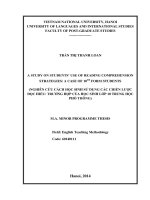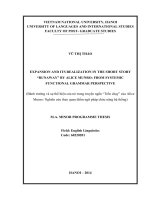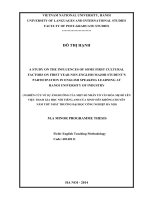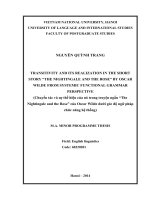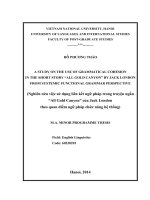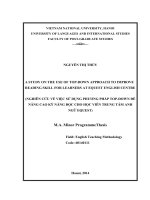A STUDY ON THE USE OF GRAMMATICAL COHESION IN THE SHORT STORY “ALL GOLD CANYON BY JACK LONDON FROM SYSTEMIC FUNCTIONAL GRAMMAR PERSPECTIVE
Bạn đang xem bản rút gọn của tài liệu. Xem và tải ngay bản đầy đủ của tài liệu tại đây (1.29 MB, 83 trang )
VIETNAM NATIONAL UNIVERSITY, HANOI
UNIVERSITY OF LANGUAGES AND INTERNATIONAL STUDIES
FACULTY OF POST-GRADUATE STUDIES
***
HÔ
̀
PHƯƠNG THA
̉
O
A STUDY ON THE USE OF GRAMMATICAL COHESION
IN THE SHORT STORY “ALL GOLD CANYON” BY JACK LONDON
FROM SYSTEMIC FUNCTIONAL GRAMMAR PERSPECTIVE
(Nghiên cư
́
u viê
̣
c sư
̉
du
̣
ng liên kê
́
t ngư
̃
pha
́
p trong truyê
̣
n ngă
́
n
“All Gold Canyon” cu
̉
a Jack London
theo quan điê
̉
m ngư
̃
pha
́
p chư
́
c năng hê
̣
thô
́
ng)
M.A. MINOR PROGRAMME THESIS
Field: English Linguistics
Code: 60220201
Hanoi, 2014
VIETNAM NATIONAL UNIVERSITY, HANOI
UNIVERSITY OF LANGUAGES AND INTERNATIONAL STUDIES
FACULTY OF POST-GRADUATE STUDIES
***
HÔ
̀
PHƯƠNG THO
A STUDY ON THE USE OF GRAMMATICAL COHESION
IN THE SHORT STORY “ALL GOLD CANYON” BY JACK LONDON
FROM SYSTEMIC FUNCTIONAL GRAMMAR PERSPECTIVE
(Nghiên cư
́
u viê
̣
c sư
̉
du
̣
ng liên kê
́
t ngư
̃
pha
́
p trong truyê
̣
n ngă
́
n
“All Gold Canyon” cu
̉
a Jack London
theo quan điê
̉
m ngư
̃
pha
́
p chư
́
c năng hê
̣
thô
́
ng)
M.A. MINOR PROGRAMME THESIS
Field: English Linguistics
Code: 60220201
Supervisor: Prof. Dr. Hong Văn Vân
Hanoi, 2014
i
DECLARATION
I, Hồ Phương Tha
̉
o, hereby declare that the work in this thesis is the result of
my own research. It is recognized that should this declaration be found to be false,
disciplinary actions could be taken and penalties could be imposed in accordance
with university policies and rules.
Hanoi, December 2014
Hồ Phương Tha
̉
o
ii
ACKNOWLEDGEMENTS
I would like to take this opportunity to express my deepest gratitude to my
supervisor, Prof. Dr. Hoàng Văn Vân, Dean of the School of Graduates, Vietnam
National University Hanoi, for his continuous support, encouragement throughout
this research. I also would like to thank him for his clear guidance, insightful
comments and dutiful supervision.
My sincere thanks also extend to all my teachers at the Faculty of
Postgraduate Studies, University of Languages and International Studies, Vietnam
National University, Hanoi, for their enthusiastic lectures during this MA program.
My sincere gratitude goes to Dr. Le Hung Tien and the staff members of the
Department of Post – Graduate Studies for their valuable support.
Finally, I wish to extend my profound thanks to my family, friends and
classmates with their whole-hearted support and encouragement.
iii
ABSTRACT
This study aims to find out grammatical cohesion in the story "All Gold
Canyon" by Jack London basing on the theoretical framework by Halliday and
Hasan (1976). The research findings show that grammatical cohesion is used in a
very high rate to connect the text together. Furthermore, among different types of
grammatical cohesive devices, reference and conjunction account for most of
cohesion with 74% and 24% respectively, which shows that the text is highly
cohesive. Substitution and ellipsis, in contrast, take up only 1% for each type. This
may indicate that there are few conversations among characters. In other words, the
imbalance use of cohesion helps depict the writing style of literary documents in
general and of Jack London in particular.
iv
TABLE OF CONTENTS
ACKNOWLEDGEMENTS i
ABSTRACT ii
TABLE OF CONTENTS iii
LIST OF TABLES AND DIAGRAMS vi
Part A – INTRODUCTION
1. Rationale of the study 1
2. Aim of the study and research questions 2
3. Scope of the study 2
4. Methods of the study 3
5. Design of the study 3
Part B – DEVELOPMENT
CHAPTER I: THEORETICAL BACKGROUND
1. Introduction 4
2. Overview of systemic functional linguistics 4
3. Cohesion 5
3.1. Text and its texture 5
3.2. The concept of cohesion 6
3.3. Types of cohesion 6
3.3.1. Lexical cohesion 8
3.3.1.1. Reiteration 8
3.3.1.2. Collocation 8
3.3.2. Grammatical cohesion 8
3.3.2.1. Reference 9
3.3.2.2. Sustitution 10
3.3.2.3. Ellipsis 11
3.3.2.4. Conjunction 11
3.4. Summary 12
v
CHAPTER 2: DATA ANALYSIS AND DISCUSSION
1. The context of the chosen text 13
2. Grammatical cohesive devices in the story ―All Gold Canyon‖ 14
2.1. Reference 15
2.1.1. Anaphoric, cataphoric and exophoric reference 15
2.1.2. Realization of different types of reference 16
2.1.2.1. Personal reference 17
2.1.2.2. Demonstrative reference 21
2.1.2.3. Comparative reference 26
2.2. Substitution 27
2.3. Ellipsis 30
2.4. Conjunction 31
Part C – CONCLUSIONS
MAJOR FINDINGS, IMPLICATIONS, LIMITATIONS
AND SUGGESTIONS FOR FURTHER STUDIES
1. Major findings 36
2. Suggestions for English learners in writing skill 38
3. Limitations and suggestions for further studies 40
3.1. Limitations 40
3.2. Suggestions for futher studies 40
REFERENCES 41
APPENDIXES . I
vi
LIST OF TABLES
Table 1: The percentage of anaphoric, cataphoric and exophoric reference
Table 2: The percentage of different types of reference
Table 3: The distribution of personal reference in the story
Table 4: The percentage of substitution in the story
Table 5: The percentage of ellipsis in the story
Table 6: The percentage of conjunction in the story
LIST OF DIAGRAMS
Diagram 1: The percentage of grammatical cohesion in the story
Diagram 2: The percentage of demonstrative reference in the story
Diagram 3: The percentage of the definite article "The" in the story
Diagram 4: The percentage of conjunctive devices in the story
1
PART A. INTRODUCTION
1. Rationale of the study
Being a learner of linguistics, I started wondering myself ―what is the function of
language?‖ It comes as no surprise that I may see language as a medium of
communication; however, it cannot be restricted to the description of the nature of
language. Linguistics, thus, becomes an appealing field for me to conduct a research
to have deeper understanding this complex nature of language.
Along with other branches of linguistics, grammar appears to be a rich land in
which many scholars are engrossed in exploring it with different theories. The
linguistics history has seen developments of various approaches to grammar, known
as traditional grammar, universal grammar, descriptive grammar or generative
grammar. However, since the appearance of systemic functional grammar (SFG), it
has received a great attention from many followers in linguistics research. In
comparison with other approaches that focus on the rules, forms that structure
language, SFG accounts for how language is used in contexts for communicative
purposes (Halliday, 1994). It concerns with both spoken and written language. SFG,
therefore, can be considered the most useful tool for text analysis.
In Vietnam, thanks to credited scholars such as Cao Xuân Hạo (1991) with Tiếng
Việt: Sơ thảo ngữ pháp chức năng, Hoàng Văn Vân (2002/2005) with Ngữ pháp
kinh nghiệm của cú tiếng Việt: Mô tả theo quan điểm chức năng hệ thống, a number
of significant researches have been conducted from SFG perspective. This provides
us, learners at the Department of Postgraduate Studies, invaluable sources of
reference as well as great inspiration to carry out more studies in this field. Among
many aspects of SFG, I have decided to conduct a study on one specific
phenomenon with the title “A Study on the Use of Grammatical Cohesion in the
Short Story “All Gold Canyon” by Jack London from Systemic Functional
Grammar Perspective”. There are two main reasons for the choice of this topic. The
first and foremost, I wish to understand more about cohesion – an essential element
2
in creating the text, and particularly to discover in what way the author used
grammatical cohesion to develop his story. Besides, I have been fascinated with
numerous Jack London’s short stories and novels since I was a high school student.
Therefore, ―All Gold Canyon‖ by Jack London turns to be a good text for my
analysis. To compare with Jack London’s other well-known works, ―All Gold
Canyon‖ appears to be unfamiliar to many readers. However, it gave me much
impression when I first read for Jack London’s development of ecological thought
and his writing style.
2. Aim of the study and research questions
The aim of this study is to investigate how Jack London uses grammatical cohesive
devices to develop his story.
In order to achieve the above aim, three research questions are raised for
exploration:
- What is grammatical cohesion as conceptualized in systemic functional
linguistics?
- How does Jack London use grammatical cohesive devices to develop the
story ―All Gold Canyon‖?
- What implications and suggestions should be made for teachers and students
of English in teaching and learning writing paragraphs and essays?
3. Scope of the study
In this study, I do not have an ambition to cover all aspects of functional grammar
and all relations providing links in a text. Only issues related to grammatical
cohesion such as framework, elements and features are taken for study. The ground
for investigation in this study is the system of cohesion and grammatical cohesion
developed by Halliday and Hasan (1976). The illustration of text analysis is the
chosen story ―All Gold Canyon‖ by Jack London.
3
4. Methods of the study
The study is undertaken with a view to examine how grammatical cohesion is used to
develop a text. Given the scope of this study, the quantitative and qualitative methods
will be employed. That is to say, this study will focus on the collection and analysis
of the study as data to explain a particular phenomenon. Counting and measuring
would be common forms for this method. These statistical results will be followed
by qualitative method which is used to gain an understanding of the underlying
reasons and the effectiveness of the application of grammatical cohesive devices in
Jack London’s ―All Gold Canyon‖ as well. The base for procedures and
conventions applied in the study is the theoretical framework of Halliday’s.
5. Structure of the study
The study consists of three main parts: introduction, development and conclusion.
The introduction presents the rationale of study, the aim and the scope of the
study. It also presents the methods employed for analysis and the outline of the
study structure.
The development is subdivided into two chapters
Chapter 1 provides the theoretical background of the study in which the main
concepts of systemic functional grammar are reviewed to establish the framework
for analysis and discussion in Chapter 2.
Chapter 2 analyzes the short story ―All Gold Canyon‖ using Halliday and Hasans’
(1976) grammatical cohesion system as the theoretical framework.
The conclusion summarizes what has been studied, points out the limitations
of the study, presents educational implications, and makes some suggestions
for future research.
4
PART B. DEVELOPMENT
CHAPTER 1 - THEORETICAL BACKGROUND
1. Introduction
This chapter is concerned with the examination of some systemic functional
concepts which are relevant for the analysis and discussion in Chapter 2. I will start
with an overview of systemic functional linguistics. Then I will look at the system
of cohesion in English, presenting in some detail the sub-types of grammatical
cohesion.
2. Overview of systemic functional linguistics
For a long time, grammar has been a branch of linguistics which has attracted much
attention from many scholars in the world. They aim to give satisfactory
explanations on the nature of language from their points of view. Chomsky’s theory
views grammar as a set of rules which allow or disallow certain sentence structures.
Ultimately, more so than traditional grammar, formal grammar concentrates on
structure, that is the way in which classes of words and phrases are combined.
Through this period of teaching both types of grammar some linguists, were
thinking to generate one more developed grammar which is functional systemic
grammar (Halliday et al, cited in Cope, 1993). Unlike the former ones, SFG is more
sociological in orientation, such that it is more concerned with relating grammar to
its function within society.
From its early birth, functional theories of grammar are those approaches to the
study of language that see the functions of language and its elements to be the key
to understand linguistic processes and structures. Functional theories of language
propose that since language is fundamentally a tool, it is reasonable to assume that
its structures are best analyzed and understood with reference to the functions they
carry out. Functional theories of grammar differ from former theories of grammar,
in that the latter seeks to define the different elements of language and describe the
way they relate to each other as systems of formal rules or operations. Meanwhile,
5
the former defines the functions performed by language and then relates these
functions to the linguistic elements that carry them out. This means that functional
theories of grammar tend to pay attention to the way language is actually used in
communicative context.
3. Cohesion
To begin with, in order to see how different things in a text ―hang together‖ to make
a text, it is important to define the notion of the text and texture.
3.1. Text and its texture
―Language is a means of conveying and obtaining information‖ (Valeika and
Buitkiene, 2006: 7). To achieve this, the units of language must perform appropriate
functions. All languages are formed of words and sentences. These sentences must
be bound together to make a text. A text is the text if there is mutual dependence
between sentences. Text can be defined as ―any passage, spoken or written, of
whatever length that forms a unified whole‖ (Halliday and Hasan, 1976: 1). In order
to create a text as a unified whole, it is necessary to know what makes text coherent.
―In its deep structure, the text is a sequence of mutually related clauses, which after
the application of appropriate textualizing operations, are turned into text sentences‖
(Valeika and Buitkiene, 2006). Furthermore in order to create mutually connected
sentences the meaning that is semantic relation of the words is important as words
and context are inseparable. Therefore, the meaning and logical relation of words
and sentences are important when creating a coherent text.
A text distinguishes from non-text by its texture. Texture ―is the property that
ensures that the text ―hangs together‖‖ (Halliday and Hasan, 1976). A text without
texture would be a group of unrelated sentences. The most important feature of the
texture is the cohesive relation called a tie that is a semantic link between two
elements. Ties ―create links across sentence boundaries and pair and chain together
items that are related‖ (McCarthy, 1991: 27). So the basic idea here is that, ties link
6
sentences and therefore creates cohesion. That is to mean, cohesion shows if there is
the connection between sentences in the text.
3.2. The concept of cohesion
Cohesion is a crucial standard of textuality. Cohesion has been defined in a number
of ways, among which Halliday and Hasan (1976) provided the most
comprehensive one. It is defined as the ―set of semantic configuration that is
typically associated with a particular class of context of situation, and defines the
substance of the text.‖ According to Halliday and Hasan, the function of cohesion is
to relate one part to another part of the same text. Consequently, it lends continuity
to the text. By providing this kind of text continuity, cohesion enables the readers
or listeners to supply all the components of the picture to its interpretation. Halliday
and Hasan (1976) identified five types of cohesion: reference, substitution, ellipsis,
conjunction, and lexical cohesion. The first four ones present grammatical cohesive
devices, whereas the last one stands for lexical relation.
3.3. Types of cohesion
In creating a coherent text, cohesion is expressed partly through the grammar and
partly through vocabulary. According to Halliday and Hasan (1976), the
classification of cohesion is based on the linguistic form. The type of cohesion
depends either on semantic relation in the linguistic system or on lexico-grammatical
relations. In other words, the cohesive relation can be interpreted as being either
lexicogrammatical or semantic. It can be made clearer in the following description:
Nature of cohesive relation
Type of cohesion
Relatedness of form
Relatedness of reference
Semantic connection
Substitution and ellipsis; lexical collocation
Reference; lexical reiteration
Conjunction
Figure 1 : Type of cohesion
(Source: Haliday and Hasan, 1976: 304)
7
Reference, substitution and ellipsis belong to grammatical; lexical cohesion, as the
name implies, lexical. Conjunction is on the borderline of the grammatical and the
lexical; the set of conjunctive element can probably be interpreted grammatically in
terms of systems, and some conjunctive expressions involve lexical selection.
However, it is better to put it in the group of grammatical cohesion as it is mainly
grammatical with a lexical component inside. Thus, we can refer to grammatical
cohesion and lexical cohesion as follows:
Grammatical cohesion
Lexical cohesion
Reference
Exophoric
Endophoric
- personal
- demonstrative
- comparative
Substitution
Norminal
substitution
Verbal substitution
Clausal
substitution
Ellipsis
Norminal ellipsis
Verbal ellipsis
Clausal ellipsis
Conjunction
Additive
Adversative
Causal
Temporal
Others
Reiteration
Same word/repetition
Synonym/near
synonyms
Superordinates
General words
Collocation
Adjective + Noun
Quantifier + Noun
Verb + Noun
Noun + Verb
Noun + Noun
Preposition + Noun
Noun + Preposition
Adverb + Verb
Verb + Verb
Verb + Preposition
Verb + Adverb
Adverb + Adjective
Adjective + Prepostion
Figure 2: Grammatical and Lexical Cohesion
8
3.3.1. Lexical cohesion
In Halliday and Hasan’s point of view, lexical cohesion deals with the meaning in
text. ―This is the cohesive effect achieved by the selection of vocabulary‖ (Halliday
and Hasan, 1976). It concerns the way in which lexical items relate to each other and
the role played by certain basic semantic relations between words to make textual
continuity. The two basic categories of lexical cohesion are reiteration and collocation.
3.3.1.1. Reiteration
Reiteration is ―the repetition of a lexical item, or the occurrence of a synonym of
some kind, in the context of reference; that is, where the two occurrences have the
same referent‖ (Halliday and Hasan, 1976). To make it clearer, Mc Carthy (1991)
also state that ―reiteration means either restating an item in a later part of discourse
by direct repetition or else reasserting its meaning by exploiting lexical relation‖.
The authors classify reiteration into four sub-types: the same word, a synonym/near-
synonym, a superordinate, and a general word. For example, ―a boy‖ can be
replaced in the following sentences with ―the boy‖ (the same word), ―the lad‖ (a
synonym/near-synonym), ―the child‖ (a superordinate), and ―the idiot‖ (a general
word) (Halliday and Hasan, 1976: 279).
3.3.1.2. Collocation
Collocation refers to the semantic and structural relation among words, which
native speakers can use subconsciously for comprehension or production of a text.
From the viewpoints of Halliday and Hasan (1976), ―word combination‖ or ―word
co-occurrence‖ is known as collocation. There are two sub-types of collocation:
grammatical collocation and lexical collocation.
3.3.2. Grammatical cohesion
As mentioned, grammatical cohesion is the specific aspect that the researcher takes
into consideration in this study. As a result, a closer look into four sub-types of
grammatical devices will be taken in hope to give an insightful analysis in the next
chapter.
9
3.3.2.1. Reference
What distinguishes this special type is the particular nature of the information that is
to be retrieved, and the cohesion lies in the continuity of reference, by which the
same thing comes into the discourse for the second time. According to Halliday and
Hasan (1976: 32), reference is a semantic relation and ―since the relationship is on
the semantic level, the reference item is in no way constrain to match the
grammatical class of the item it refers to‖. The two authors also identified
situational and textual reference very clearly by contrasting exophora (or exophoric
reference) and endophora (endoforic reference) as follows:
Reference
[situational] [textual]
exophora endophora
[to preceding text] [to following text]
anaphora cataphora
(Source: Halliday and Hasan, 1976: 32)
Reference items can be exophoric or endophoric, and if it is endophoric, it may be
anaphoric or cataphoric. An exophoric item does not name anything and does not
give a significantly greater amount of information. It signals that the reference must
be made to the context of situation. It does not bind two elements into text, it takes
us outside the text for interpretation. Only endophoric reference is cohesive and it
contributes to the integration of the passage with another to form coherent text.
Endophoric reference can be divided into two areas: anaphoric and cataphoric.
Anaphoric refers to any reference that points ―backwards‖ to previously mentioned
information in text. Whereas, cataphoric reference points the reader or listener
―forward‖. It draws us further into the text in order to interpret.
10
Eg: John is a big man. He loves children.
anaphoric
Thinking about her work, No is so proud.
cataphoric
Functionally speaking, there are three main types of cohesive reference. They are
personal, demonstrative and comparative references. Let us look at the examples of
each type as follow:
Mikhail Gorbachev didn’t have to change the world. He could have chosen to rule
personal reference
much as his predecessors did.
Recognizing that his country had to change, Gorbachev could have become a
cautious modernizer in the Chinese fashion, promoting economic reform and
sponsoring new technology while holding firm against political change. This did not
demonstrative reference
happen.
A: Would you like these seats ?
B: No, as a matter of fact, I’d like the other seats.
comparative reference
(Source: Nunan, 1993: 23)
3.3.2.2. Substitution
Halliday and Hasan (1976) state that substitution takes place when one feature
replaces a previous word or expression. In Bloor and Bloor (1995: 96), the two
linguistics also claim that substitution is used when ―a speaker or writer wishes to
avoid the repetition of a lexical item and is able to draw on one of the grammatical
resources of the language to replace the item. For instance: “I left my pen at home,
do you have one?” In this example, ―one” is replaced or substitution for “pen”. The
three types of classification for substitution: nominal, verbal and clausal reflect its
grammatical function. In nominal substitution, the most typical substitution words
are “one”, “ones” “same” and they substitute nouns. In addition, all, any, each,
11
either, neither, some and none can behave in the same way. In verbal substitution,
the most common substitute is the verb “do”. It operates as a head of a verbal group
in which it can be occupied by the lexical verb. Finally, in clausal substitution, what
is presupposed is not an element within the clause but an entire clause. The common
linguistic items realized are “so” or “not”.
3.3.2.3. Ellipsis
The relation between substitution and ellipsis is very close because it is merely that
ellipsis is ―substitution‖ by zero. What distinguishes in ellipsis is that some
elements are omitted from the surface of the text, but they are still understood.
Thus, omission of these elements can be recovered by referring to an element in the
preceding text. There are three types of ellipsis: nominal, verbal and clausal ellipsis.
In nominal ellipsis, it can be divided into five sub-types: specific deictic, non-
specific deictic, post-deictic, numerative and epithets. In verbal group, ellipsis is
shown by the presence of mood but the absence of residue. Lastly, clausal ellipsis
takes the presupposing clause as a basic structure where ellipsis occurs in
constituents like the subject, complement, predicator and adjunct. The missing part
can be retrieved from the presupposed structure in another sentence. In the
following example taken from Halliday (1994: 318), a clause is omitted and it is
called clausal ellipsis.
A: Can you row?
B: Yes. [I can row]
3.3.2.4. Conjunction
Conjunction differs from other cohesive ties because it reaches the meaning by
using other features in the discourse. Bloor and Bloor (1995: 98) describe
conjunction as a ―cohesive tie between clauses or sections of text in such a way as
to demonstrate a meaningful pattern between them‖. In other words, conjunction is
used to connect sentences and clauses together into one text. Halliday and Hasan
(1976: 242-243) classify conjunction into four types: additive, adversative, causal
12
and temporal. Firstly, additive conjunction acts to add meaning among sentences. It
is signaled through and, also, moreover, in addition, besides, etc. Whereas,
adversative conjunction acts to indicate ―contrary to expectation‖. It is realized by
some typical conjunctions like but, yet, though, however, on the contrary, etc.
Thirdly, causal conjunction expresses ―result, reason and purpose‖. This kind of
relation is expressed by some items such as: so, hence, therefore, however,
consequently, because, etc. The last conjunctive category is temporal that creates a
unified and tied discourse. That is to say, discourse appears as a process of an
episode with the development of a time sequence. There are three main types of
temporal relation namely simple, complex and conclusive temporal relation.
3.4. Summary
This chapter has reviewed some basic concepts related to the study. It presented the
system of English cohesion which is represented in two main types: grammatical
cohesion and lexical cohesion. For the scope of study, only the theoretical
background of grammatical cohesion would be the framework for my chosen text
analysis in the following chapter.
13
CHAPTER 2:
DATA ANALYSIS OF GRAMMATICAL COHESION USED
IN THE STORY "ALL GOLD CANYON"
In this chapter, I will analyze the story ―All Gold Canyon‖ in terms of grammatical
cohesion. The analysis is based on the framework of Halliday and Hasans’ (1976)
Cohesion in English. In order to have a better understanding of the story, I will
present the context of the chosen text. Then I will analyze the story into types of
grammatical cohesion through data statistics as shown in appendices I, II, III, IV.
Afterwards, I will discuss what I have analyzed to see how grammatical cohesion is
exploited to construct the story by the writer.
1. The context of the chosen text
The data of this analysis is a short story ―All Gold Canyon‖ by Jack London. The
author was born as a poor boy in 1876 in San Francisco and died ―rich‖ and famous
in 1916, during World War I. Throughout his life, London was a prolific American
author who is celebrated for his powerful depiction of nature and the human struggle
for survival. His novels and short stories have influenced many writers after him,
and his writings about nature have made him a respected figure of this time.
Because of Jack London’s vigorous, muscular style of writing he remains one of the
most widely read American authors in the world. Between 1900 and 1916 he
completed more than 50 fiction and non-fiction books, hundreds of short stories and
numerous articles. Several of the books and many of the short stories are classics
and still popular; some have been translated into as many as 70 languages. Among
the best known are Call of the Wild, White Fang, The Sea Wolf, Martin Eden and
John Barleycorn.
The story ―All Gold Canyon‖ was written in 1905 and first published in The New
Century magazine. In ―All Gold Canyon‖, London not only notices for the first time
in his career that greed and desire are in conflict with the ecosystem, but he begins to
develop an ethical concern for nature. The story is the tale of human greed, gold and
14
death. The story begins with a beautiful picture of a place in nature. London lyrically
describes the beauty and tranquility of the valley in the first seven paragraphs. In the
valley, animals, plants, and their physical environment are in perfect harmony.
However, the tranquility of the place is shattered by the destruction of a resource-
oriented pocket-miner named Bill, who despoils and destroys the valley in search of
gold. Man's greed for gold leads to the destruction of the slope and even human's
death. At the end of the story, London describes a fight between Bill and another
gold-hunter and this fight ends with the death of the strange man.
2. Grammatical cohesive devices in the story "All Gold Canyon"
According to Halliday and Hasan (1976), grammatical cohesive devices include
reference, substitution, ellipsis and conjunction. These cohesive devices will be
analyzed in details basing on the framework built by Halliday and Hasan (1976).
All cohesive items in each type in the story will be collected, classified and then
significant characteristics of the story will be drawn out basing on the frequency of
use of different types of grammatical cohesion.
From the data collected (see Appendix I, II, III, IV), it can be seen that the total of
grammatical cohesive devices used in the story "All Gold Canyon" are 2198 ties, in
which reference accounts for the largest part with 1627 ties, presenting for 74%.
Conjunction comes second with 542 ties or 24%. Substitution and ellipsis explain for
the smallest percentage with only 1% of each type. The distribution of grammatical
cohesive devices in this story can be illustrated in the diagram below:
Diagram 1: The percentage of grammatical cohesion in the story
74%
1%
1%
24%
Reference
Substitution
Ellipsis
Conjunction
15
From the diagram, it can be seen that there is a big difference in the way London
employs grammatical cohesive devices in his work. While reference and
conjunction are restored frequently, substitution and ellipsis are used in an
extremely small quantity with less than 1% for each type.
2.1. Reference
2.1.1 Anaphoric, cataphoric and exophoric reference
Basing on the statistics collected from the data, reference is known as the largest
part of grammatical cohesion. Reference, in other words, is the most important part
in creating cohesion in particular or creating text in general. The table below shows
the percentage of anaphoric, cataphoric and exophoric reference in the story.
Reference
Number of
items
Percentage
(%)
Anaphoric
1299
79.8%
Cataphoric
158
9.7%
Exophoric
170
10.5%
Total
1627
100%
Table 1: The percentage of anaphoric, cataphoric and exophoric reference
Obviously, anaphoric reference takes up the largest part with 79.8%. Anaphoric
reference is found in the whole story, but falls on mainly on personal pronouns and
determiners such as he, him, his, that and definite article the. Surprisingly,
exophoric reference ranks second with 170 ties accounting for 10.5%. Exophoric
reference does not refer readers backward or forward to connect the text. It is
understood basing on background knowledge of readers or listeners. Because in this
story, Jack London describes the beauty of a place in nature in seven first
paragraphs, exophoric reference tends to be employed in high rate here. Standing in
the last position is cataphoric reference with 9.7%. Interestingly, among 158 items
in this group, the definite article the is restored 123 times (see Appendix I).
16
2.1.2. Realization of different types of reference
Although a text can be analyzed in terms of anaphoric, cataphoric and exophoric
reference, this classification is mainly related to grammatical features of a text and
it helps to deal with grammatical exercise. However, in this study, a narrative is
studied in light of literature, the analysis of anaphoric, cataphoric and exophoric
reference is inappropriate. Instead, reference items in the narrative "All Gold
Canyon" should be dealt with in respect of three types classified by Halliday and
Hasan (1976) namely personal, demonstrative and comparative. Personal reference
is expressed through the category of person and it includes personal pronouns and
personal determiners. Demonstrative reference expresses the relation of location on
a scale of proximity while comparative reference is indirect reference expressed
through using identity or similarity. In this story, Jack London applies the different
types of reference unevenly. While personal and demonstrative reference occur
frequently, comparatives is hardly used. Personal reference ranks first with 825 ties,
representing for 51%, demonstrative ranks second with 775 ties, accounting for
48% and comparative reference ranks last with only 24 ties or 1%. The frequency of
use of reference in the story will be presented in the table below:
Type of
Reference
Number of
Items
Percentage (%)
Personal
825
51%
Demonstrative
775
48%
Comparative
24
1%
Total
1624
100%
Table 2: The percentage of different types of reference
The table shows that the writer links the text by personal and demonstrative
reference instead of comparative one. The high frequency of occurrence of personal
and demonstrative reference can illustrate features of narrating instead of comparing
or discussing in the story "All Gold Canyon".
17
2.1.2.1. Personal Reference
According to Halliday and Hasan (1976: 43) the category of personals includes the
three classes: personal pronouns, possessive determiners and possessive pronouns.
The number of members in each category can function as the structural roles and
help identify the relations among people and objects in the texts.
Totally, in the story, Jack London uses 825 personal reference ties including the
first, the second and third personal pronouns and determiners. The first person
pronouns and determiners which are illustrated as I, my, me in the story occupy 57
items accounting for 6, 9%; the second person pronouns and determiners presented
as you, your, yours take up 41 items presenting for 4.9%; and the third person
pronouns and determiners described as he/ his/ him/ himself/ they/ them/ their/
themselves/ it/ its/ itself/ that include 727 ties, making up 88,2% (see Appendix I).
The details of the distribution of personal reference are illustrated as follows:
Pronouns
Numbers of examples
Percentage (%)
I, my, me
57
6.9%
You, your, yours
41
4.9%
He, him, his, himself
568
69.0%
It, its, itself
85
10.3%
They, them, their,
themselves
26
3.1%
That
48
5.8%
Total
825
100%
Table 3: The distribution of personal reference in the story
Basing on the way the writer takes advantage of personal reference, relations
between or among characters in the story can be guessed. It is common that the first
person pronouns and determiners are commonly used in speeches, dialogues and
inner monologues; hence texts employing these cohesive devices tend to be

